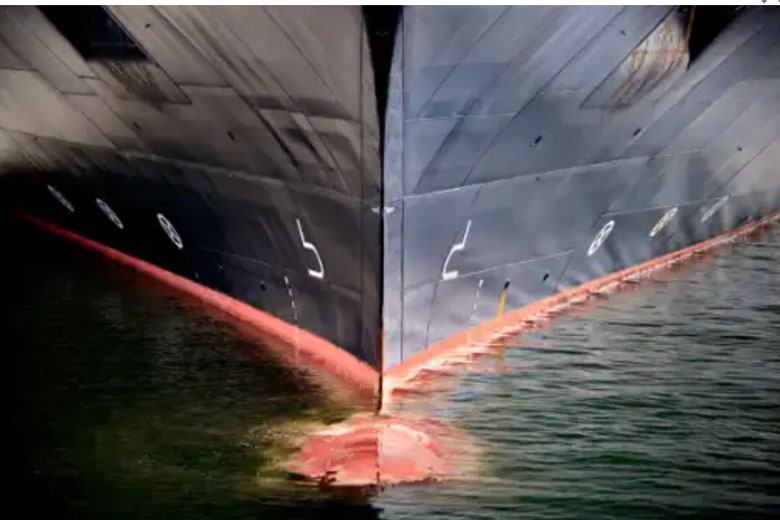In the 19th century, Plymouth, Mass. was home to a famous factory that produced much of the world’s rope and twine for ship rigging. Now, in the same factory space, a company is seeking to revolutionize ship maintenance through robotics.
At the Cordage Commerce Center, Greensea IQ manufactures robots which can autonomously clean much of a ship’s hull while the ship is submerged. The company provides the robot service to help ships regularly clean microorganisms, plants, and algae that accumulate on a ship’s surface.
The service currently is available in more than a dozen ports, including in New York, Quebec, and Virginia, and the company hopes to expand its presence on the eastern seaboard.
The robot uses motors to create a suction to stay within cleaning distance of the ship hull as brushes clean it.
Shipowners have long sought new ways to combat the accumulation of organic material, or biofoul, on boat hulls. This accumulation can lead to corrosion, and it can slow down boats, leading to decreased fuel efficiency.
Traditionally, boat owners have needed to either pull their boats from the water for a cleaning or hire divers to clean boat hulls. In recent years, however, companies have been attempting to develop cleaning robots.
Early versions of these robots relied on detailed maps of the boats to clean, or required humans to steer them, according to Dawn D’Angelillo, Greensea IQ’s director of marketing.
“There’s been people trying to solve the problem over time, and where they’ve kind of gotten hung up is navigating the ship hull,” D’Angelillo said.
In 2017, the United States Navy launched a new round of an initiative that encourages small businesses to develop commercial tools that may also help the Navy solve problems. For this initiative, Greensea IQ engineers and researchers with the Florida Institute of Technology developed the robotic technology the company now is using to clean ships.
Instead of relying on GPS technology, which often cuts out underwater, they designed the robot to use several sensors to constantly calculate a dead reckoning of its position in relation to its surroundings. It’s a similar process to what sailors used to find their position before GPS or radar technology, but the robot does it much more rapidly, D’Angelillo said.
“As the crawler moves along the ship, it will know where it is in space without having to use a map or have eyes on it or anything,” she said.
The robot uses motors to create a suction to stay within cleaning distance of the ship hull as brushes clean it. The robot can clean most of the ship, but divers may be needed to supplement the labor on irregular parts of the boat, like propellers and ship grates. The robot also inspects the boat hull as it goes, and the data it gathers can be compiled into a report of hull health.
D’Angelillo says Greensea IQ has several cruise boats as clients. The company is one of several companies competing in the robotic boat-cleaning service space. The Australian company Hullbot, for example, has partnered with the ferry line FRS Clipper to clean a fleet of vessels in the Seattle area.
In the Plymouth facility, Greensea IQ also manufactures a robot which can navigate beaches and shallow ocean terrains in the tidal surf zone. Greensea IQ acquired the technology for this robot when it acquired another company, C-2 Innovations Inc., in 2022.
The semi-autonomous rover vehicle can be used for research, monitoring, and military purposes. Both robots use an integrated sensor platform developed by Greensea IQ and other researchers. This platform, called OPENSEA, helps various oceanic sensors “talk” to each other. Without an open platform, many sensors often require their own independent computing systems to operate, which can add to the weight and complexity of the robots. As marine remotely operated vehicles (ROVs) carry out more complex missions for aquatic research, they have become more bulky with each new sensor.
For example, the weight of Jason, one of the ROVs used by the Woods Hole Oceanographic Institution (WHOI), has ballooned from 6,000 pounds to over 10,000 pounds during its time in use, said Andrew. D. Bowen, a lead WHOI engineer, in Oceans, the institution’s publication.
WHOI and Greensea IQ have partnered to use the company’s OPENSEA platform to help in the development of two new medium-sized ROVs that will weigh much less thanks to sensor integration. Construction on the smaller ROVs began in the fall of 2024.
This new generation of ROVs will give ocean researchers more options for their remotely operated dives, said Bowen.
“We don’t always need the heavy-lifting capability of Jason, so the medium-sized ROVs will give the community more options,” Bowen said.
Greensea IQ employs about 45 to 50 employees in its Plymouth facility, said D’Angelillo. In 2024, the company was presented with an Blue Future Anchor Institution award by the Plymouth Foundation, a nonprofit dedicated to community and economic development in the town and area.
Stephen Cole, executive director of The Plymouth Foundation, said in a statement that the company’s work enhances the local economy and “places Plymouth at the forefront of technological innovation in the blue economy.”





